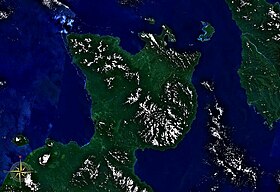Gazelle Peninsula



The Gazelle Peninsula is a large
History
The peninsula was named by Prussian explorer Georg von Schleinitz after his ship, SMS Gazelle.
1884-1909
1884: German forces seized territories of what is known (as of April 22, 2019) as German New Guinea and New Britain. 1899: Until this point the German New Guinea Company controlled these territories, then control was relinquished to the Imperial Government. 1909: Administrative headquarters of the Imperial Government in Papua New Guinea were relocated to Rabaul. [5]
1914-1937
1914: Australian forces seized and controlled Papua New Guinea. 1921: Australia was mandated Papua New Guinea by the League of Nations. 1937: Vulcan and Tavurvur erupted, resulting in the destruction of Rabaul. [5]
1941-1966
1941: Suspension of Australia's mandated Papua New Guinea was absolved when Japan seized control of Rabaul until 1945. 1946: Trusteeship of Papua New Guinea was awarded to Australia by the United Nations General Assembly. 1966:
Culture
The indigenous people of the Gazelle Peninsula are mostly concentrated within the Rabaul caldera, particularly the town of Rabaul.
Ethnically the people are typically of Melanesian descent and are referred to as Tolai by title of government. A second and less common indigenous people referred to as Baining, are semi-nomadic and tend to live in the Baining Mountains. They are distinct from the Tolai's Melanesian ethnicity. The Tolai are regarded as being the most successful people of Papua New Guinea; defined by wealth, sophistication, adaptation to modern culture, and instinct for trade.
In Tolai society, currency is used in similar fashion to coin via the medium known as tambu, a shell. Tambu can be bound together as coils to form alternative values and may be used to purchase goods in the Gazelle Peninsula. Marriage for Tolai is typically handled in economic fashion between two groups known as moieties and the son of one family is responsible for paying the bride-price in tambu to the family of the daughter. Marriage of two people within the same moiety is not allowed and the bride-price is generally determined by family status and wealth of the daughter.[6][7]
Administrative divisions
Administratively, the peninsula falls under
- Central Gazelle Rural
- Inland Baining Rural
- Lassul Baining Rural
- Livuan-Reimber Rural
- Vunadidir-Toma Rural
Villages
References
- ^ Andree, R. (1895). New Guinea, Papuan Archipelago (Online image). Retrieved April 22, 2019 from https://www.davidrumsey.com/luna/servlet/detail/RUMSEY~8~1~31748~1150678#
- ^ "Summit of Mount Sinewit". wikimapia.
- ^ "Mount Sinewit, Papua New Guinea". Peakbagger.com.
- ^ The Editors of Encyclopædia Britannica, (2015). Gazelle peninsula. Retrieved April 23, 2019 from https://www.britannica.com/place/Gazelle-Peninsula
- ^ a b c Macban, R.P. (1970). Geology of the gazelle peninsula, tpng. Record (1970/063), 8. Retrieved April 22, 2019 from https://d28rz98at9flks.cloudfront.net/12476/Rec1970_063.pdf
- JSTOR 40327773.
- JSTOR 20703948.
